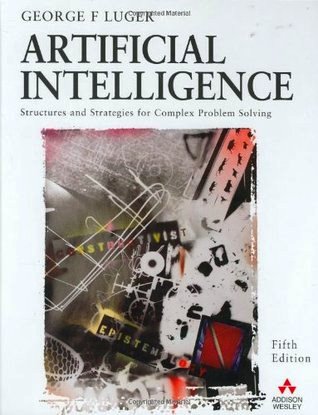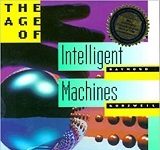| Book Name: | Artificial Intelligence: Structures and Strategies for Complex Problem Solving |
| Category: | Artificial Intelligence |
| Language: | English |
| Format: | |
| Free Download: | Available |
Free Download Artificial Intelligence: Structures and Strategies for Complex Problem Solving PDF Book

Description of Book
In this comprehensive and accessible handbook, George Luger captures the essence of artificial intelligence by solving complex problems that arise wherever computer technology is applied. Ideal for an AI undergraduate course, it first covers the basics of the major and then goes into detail with the practical information needed for implementing the algorithms and strategies discussed. essay. Readers learn how to use a number of different software tools and techniques to solve many of the challenges IT professionals face today.
Artificial Intelligence: Structures and strategies for solving complex problems are ideal for a one- or two-semester college course in AI. In this accessible and comprehensive text, George Luger captures the essence of artificial intelligence: solving complex problems that arise everywhere applies. Ideal for an AI undergraduate course, the sixth edition first covers the basics of the discipline and then goes into detail with the practical information needed for implementing algorithms and strategies. discussed strategy. Readers learn how to use a number of different software tools and techniques to solve many of the challenges IT professionals face today.
About Author
Table of contents:
Title Page……Page 4
Copyright……Page 5
Preface……Page 8
Publisher’s Acknowledgements……Page 17
Contents……Page 20
PART I: ARTIFICIAL INTELLIGENCE: ITS ROOTS AND SCOPE……Page 26
1.1 From Eden to ENIAC: Attitudes toward Intelligence, Knowledge, and Human Artifice……Page 28
1.2 Overview of AI Application Areas……Page 45
1.3 Artificial Intelligence—A Summary……Page 55
1.4 Epilogue and References……Page 56
1.5 Exercises……Page 58
PART II: ARTIFICIAL INTELLIGENCE AS REPRESENTATION AND SEARCH……Page 60
2.1 The Propositional Calculus……Page 70
2.2 The Predicate Calculus……Page 75
2.3 Using Inference Rules to Produce Predicate Calculus Expressions……Page 87
2.4 Application: A Logic-Based Financial Advisor……Page 98
2.6 Exercises……Page 102
3.0 Introduction……Page 104
3.1 Graph Theory……Page 107
3.2 Strategies for State Space Search……Page 118
3.3 Using the State Space to Represent Reasoning with the Predicate Calculus……Page 132
3.5 Exercises……Page 146
4.0 Introduction……Page 148
4.1 Hill Climbing and Dynamic Programming……Page 152
4.2 The Best-First Search Algorithm……Page 158
4.3 Admissibility, Monotonicity, and Informedness……Page 170
4.4 Using Heuristics in Games……Page 175
4.5 Complexity Issues……Page 182
4.6 Epilogue and References……Page 186
4.7 Exercises……Page 187
5.0 Introduction……Page 190
5.1 The Elements of Counting……Page 192
5.2 Elements of Probability Theory……Page 195
5.3 Applications of the Stochastic Methodology……Page 207
5.4 Bayes’ Theorem……Page 211
5.5 Epilogue and References……Page 215
5.6 Exercises……Page 216
6.0 Introduction……Page 218
6.1 Recursion-Based Search……Page 219
6.2 Production Systems……Page 225
6.3 The Blackboard Architecture for Problem Solving……Page 242
6.4 Epilogue and References……Page 244
6.5 Exercises……Page 245
PART III: CAPTURING INTELLIGENCE: THE AI CHALLENGE……Page 248
7.0 Issues in Knowledge Representation……Page 252
7.1 A Brief History of AI Representational Systems……Page 253
7.2 Conceptual Graphs: A Network Language……Page 273
7.3 Alternative Representations and Ontologies……Page 283
7.4 Agent Based and Distributed Problem Solving……Page 290
7.5 Epilogue and References……Page 295
7.6 Exercises……Page 298
8.0 Introduction……Page 302
8.1 Overview of Expert System Technology……Page 304
8.2 Rule-Based Expert Systems……Page 311
8.3 Model-Based, Case Based, and Hybrid Systems……Page 323
8.4 Planning……Page 339
8.5 Epilogue and References……Page 354
8.6 Exercises……Page 356
9.0 Introduction……Page 358
9.1 Logic-Based Abductive Inference……Page 360
9.2 Abduction: Alternatives to Logic……Page 375
9.3 The Stochastic Approach to Uncertainty……Page 388
9.4 Epilogue and References……Page 404
9.5 Exercises……Page 406
PART IV: MACHINE LEARNING……Page 410
10.0 Introduction……Page 412
10.1 A Framework for Symbol-based Learning……Page 415
10.2 Version Space Search……Page 421
10.3 The ID3 Decision Tree Induction Algorithm……Page 433
10.4 Inductive Bias and Learnability……Page 442
10.5 Knowledge and Learning……Page 447
10.6 Unsupervised Learning……Page 458
10.7 Reinforcement Learning……Page 467
10.8 Epilogue and References……Page 474
10.9 Exercises……Page 475
11.0 Introduction……Page 478
11.1 Foundations for Connectionist Networks……Page 480
11.2 Perceptron Learning……Page 483
11.3 Backpropagation Learning……Page 492
11.4 Competitive Learning……Page 499
11.5 Hebbian Coincidence Learning……Page 509
11.6 Attractor Networks or “Memories”……Page 520
11.7 Epilogue and References……Page 530
11.8 Exercises……Page 531
12.0 Genetic and Emergent Models of Learning……Page 532
12.1 The Genetic Algorithm……Page 534
12.2 Classifier Systems and Genetic Programming……Page 544
12.3 Artificial Life and Society-Based Learning……Page 555
12.4 Epilogue and References……Page 566
12.5 Exercises……Page 567
13.0 Stochastic and Dynamic Models of Learning……Page 568
13.1 Hidden Markov Models (HMMs)……Page 569
13.2 Dynamic Bayesian Networks and Learning……Page 579
13.3 Stochastic Extensions to Reinforcement Learning……Page 589
13.4 Epilogue and References……Page 593
13.5 Exercises……Page 595
PART V: ADVANCED TOPICS FOR AI PROBLEM SOLVING……Page 598
14.0 Introduction to Weak Methods in Theorem Proving……Page 600
14.1 The General Problem Solver and Difference Tables……Page 601
14.2 Resolution Theorem Proving……Page 607
14.3 PROLOG and Automated Reasoning……Page 628
14.4 Further Issues in Automated Reasoning……Page 634
14.6 Exercises……Page 642
15.0 The Natural Language Understanding Problem……Page 644
15.1 Deconstructing Language: An Analysis……Page 647
15.2 Syntax……Page 650
15.3 Transition Network Parsers and Semantics……Page 658
15.4 Stochastic Tools for Language Understanding……Page 674
15.5 Natural Language Applications……Page 683
15.6 Epilogue and References……Page 691
15.7 Exercises……Page 692
PART VI: EPILOGUE……Page 696
16.0 Introduction……Page 698
16.1 Artificial Intelligence: A Revised Definition……Page 700
16.2 The Science of Intelligent Systems……Page 713
16.3 AI: Current Challanges and Future Directions……Page 723
16.4 Epilogue and References……Page 728
Bibliography……Page 730
Artificial Intelligence. Structures and Strategies for Complex Problem Solving. Sixth Edition
Author(s): George F. Luger
Publisher: Addison Wesley, Year: 2009
ISBN: 0321545893,9780321545893









![[PDF] Draw Buildings and Cities in 15 Minutes Draw Buildings and Cities in 15 Minutes pdf](https://www.freepdfbook.com/wp-content/uploads/2021/06/Draw-Buildings-and-Cities-in-15-Minutes-218x150.jpg)








![[PDF] Digital Image Processing An Algorithmic Introduction Using Java Digital Image Processing An Algorithmic Introduction Using Java](https://www.freepdfbook.com/wp-content/uploads/2022/06/Digital-Image-Processing-An-Algorithmic-Introduction-Using-Java.jpg)




![[PDF] 43 Years JEE ADVANCED + JEE MAIN Chapterwise & Topicwise Solved Papers 43 Years JEE ADVANCED (1978-2020) + JEE MAIN Chapterwise & Topicwise Solved Papers Physics PDF](https://www.freepdfbook.com/wp-content/uploads/2022/03/43-Years-JEE-ADVANCED-1978-2020.jpg)

![[PDF] Problems in Physical Chemistry for JEE (Main & Advanced) Problems in Physical Chemistry for JEE (Main & Advanced) Free PDF Book Download](https://www.freepdfbook.com/wp-content/uploads/2022/03/Problems-in-Physical-Chemistry-for-JEE-Main-Advanced.jpg)
![[PDF] Engineering Physics (McGraw Hill)](https://www.freepdfbook.com/wp-content/uploads/2021/05/bafc8c2685bb6823a9c56134f7fba5df.jpeg)

![[PDF] Engineering Chemistry By Shashi Chawla](https://www.freepdfbook.com/wp-content/uploads/2022/05/Theory-And-Practicals-of-Engineering-Chemistry-By-Shashi-Chawla-free-pdf-book.jpeg)
![[PDF] Chemistry: An Introduction to Organic, Inorganic & Physical Chemistry Chemistry: An Introduction to Organic, Inorganic & Physical Chemistry](https://www.freepdfbook.com/wp-content/uploads/2022/04/Chemistry-An-Introduction-to-Organic-Inorganic-Physical-Chemistry.jpg)
![[PDF] Essentials of Physical Chemistry Essentials of Physical Chemistry Free PDF Book by Bahl](https://www.freepdfbook.com/wp-content/uploads/2022/04/Essentials-of-Physical-Chemistry-bahl.jpg)
![[PDF] Biological control of plant-parasitic nematodes: soil ecosystem management in sustainable agriculture Biological control of plant-parasitic nematodes: soil ecosystem management in sustainable agriculture](https://www.freepdfbook.com/wp-content/uploads/2022/05/Biological-control-of-plant-parasitic-nematodes-soil-ecosystem-management-in-sustainable-agriculture.jpg)
![[PDF] Human Anatomy: Color Atlas and Textbook Human Anatomy: Color Atlas and Textbook Free PDF Book](https://www.freepdfbook.com/wp-content/uploads/2022/05/Human-Anatomy-Color-Atlas-and-Textbook.jpg)
![[PDF] Concepts of Biology Book [Free Download]](https://www.freepdfbook.com/wp-content/uploads/2022/05/Concepts-of-Biology.jpg)
![[PDF] Essentials of Biology [Free Download] Essentials of Biology Free PDF BOok Download](https://www.freepdfbook.com/wp-content/uploads/2022/05/Essentials-of-Biology-Free-PDF-Book-Downlaod.jpg)
![[PDF] Human Biology Book [Free Download]](https://www.freepdfbook.com/wp-content/uploads/2022/05/PDF-Human-Biology-Book-Free-Download.jpg)


![[PDF] AI Crash Course AI Crash Course: A Fun and Hands-on Introduction to Machine Learning PDF](https://www.freepdfbook.com/wp-content/uploads/2022/08/AI-Crash-Course-A-Fun-and-Hands-on-Introduction-to-Machine-Learning-PDF-160x150.jpg)